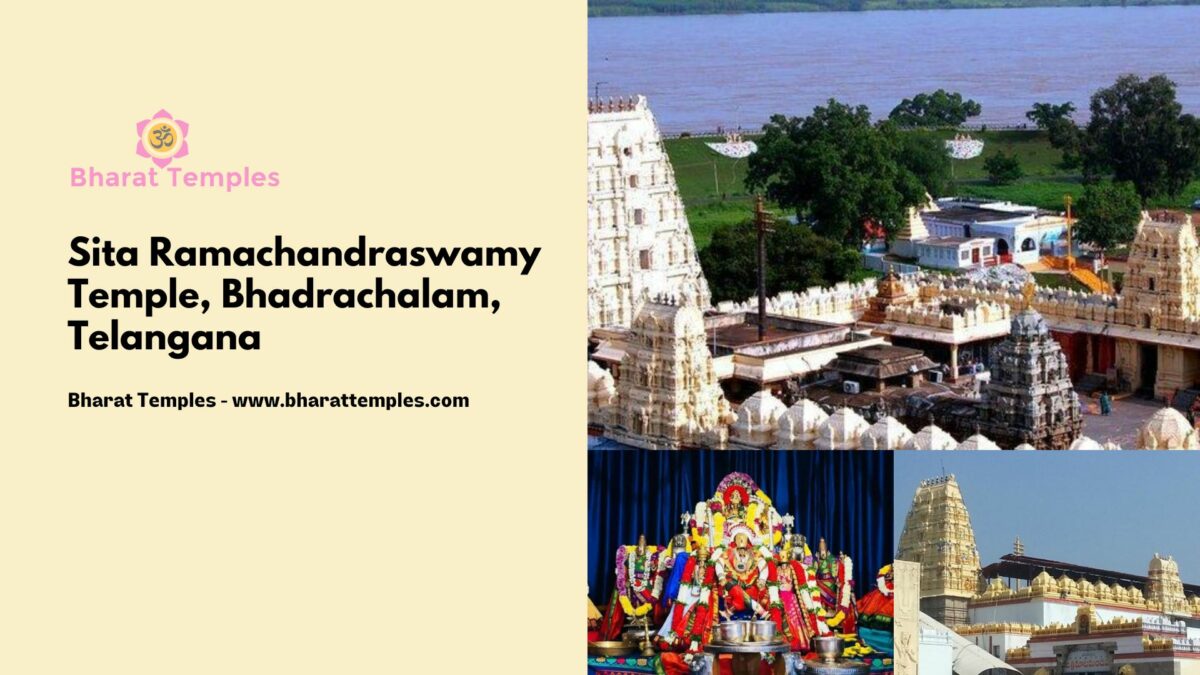Contents
The Sri Sita Ramachandraswamy temple is a South Indian Hindu temple dedicated to Rama, the seventh incarnation of the god Vishnu. It is located on the shores of the Godavari River in the town of Bhadrachalam, a part of the Bhadradri Kothagudem district in Telangana state. Often simply referred to as Bhadrachalam or Bhadradri, the temple is considered one of the Divya Kshetrams of Godavari and is also revered as Dakshina Ayodhya. According to the legend, Vishnu appeared to Meru‘s son Bhadra as Rama to answer the latter’s prayers. However, Vishnu forgot that Rama was a mortal human and appeared as Vaikuntha Rama with four hands. Sita and Lakshmana form part of the temple’s moolavar.
The self-manifested moolavar was discovered in the 17th century by Pokala Dhammakka, a tribal woman living in Bhadrareddypalem. After she built a mandapam for the idols, Bhadrachalam’s tehsildar Kancherla Gopanna constructed this temple during the reign of Abul Hasan Qutb Shah. After Gopanna, Tumu Lakshmi Narasimha Dasu and Varada Ramadasu looked after the temple’s rituals. Bhadrachalam follows the Vaishnavite Pancharatra Agama tradition, and its system of worship is modelled on that of the Ranganathaswamy temple in Srirangam. The temple has four entrances; the Rajagopuram is located at the northern entrance, which is called the Vaikuntha Dwaram. The temple houses a number of sub-shrines and a few mandapams.
Bhadrachalam is notable for its principal deity Vaikuntha Rama, a form of Rama not found anywhere else in the country. According to the Brahma Purana, the temple’s deity is capable of imparting knowledge to those who worship him. Gopanna used Bhadrachalam as a centre of the Bhajan tradition to spread awareness of the Vaishnavite tradition. The annual Brahmotsavam is the biggest festival celebrated in Bhadrachalam; the key event is the Sri Sitarama Thirukalyana Mahotsavam, or the marriage of Rama and Sita on the eve of Sri Rama Navami. Other important festivals celebrated in Bhadrachalam are Vaikuntha Ekadashi, Vasanthotsavam, and Vijayadashami.
| Date built: | – |
|---|---|
| Deity: | Sita, Rama |
| Architectural style: | – |
| Major festivals | Vasantha Paksha Prayukta Srirama NavamiBrahmotsavam; Vaikuntha Ekadashi; Vijayadashami |
| Locale: | Bhadrachalam |
| District:: | Bhadradri Kothagudem |
| Address: | Temple Rd, Bhadrachalam, Telangana 507111 |
| Phone | 08743232428 |
History of Sita Ramachandraswamy Temple
The Sita Ramachandraswamy Temple has a rich history that dates back to the 17th century. The temple was built by Kancharla Gopanna, who was a revenue officer under the rule of Tani Shah of Golconda. Kancharla Gopanna was a devout devotee of Lord Rama and spent a significant portion of his revenue on the construction of the temple.
Significance of Sita Ramachandraswamy Temple
The Sita Ramachandraswamy Temple is considered to be one of the most significant temples in Telangana. The temple is dedicated to Lord Rama, his consort Sita, and his brother Lakshmana. The temple is also known as the Bhadrachalam temple and is believed to be the place where Lord Rama, Sita, and Lakshmana stayed during their exile.
The temple is also famous for its association with the famous Telugu poet-composer Kshetrayya. It is believed that Kshetrayya used to sing his compositions in the temple and was a devout follower of Lord Rama.
Architecture and Design of Sita Ramachandraswamy Temple
In the 17th century CE, Pokala Dhammakka, a tribal woman living in Bhadrareddypalem, found the central icon of Rama in an anthill. She dissolved the anthill using the water from the Godavari River. With the help of the villagers, Dhammakka constructed a mandapam (hall) and offered prayers to the deities. During the reign of Abul Hasan Qutb Shah (1672-1686), Kancherla Gopanna served as the tehsildar(revenue officer) of Bhadrachalam. Gopanna was given the title of Ramadas (Rama’s servant) by Kabirdas, a Muslim saint who was impressed with his charity. Following the Shah’s orders, Gopanna enforced the Jaziya tax, a penalty designed to force Hindus to adopt Islam.Observing the dilapidated state of the temple, Gopanna decided to build a temple for the deity by raising donations. In the initial attempt, Gopanna received harsh criticism from the local Hindus for enforcing the tax. Dejected by numerous rebuffs, Gopanna decided to use a portion of the tax collected to build the temple and face the consequences.
The temple was completed at a cost of nearly six lakh varahas. After learning the truth, the Shah was enraged, and Gopanna was summoned to the court. Gopanna explained that he never intended to misuse the treasury funds and planned to reimburse using donations he expected to receive in the future. The Shah ordered his soldiers to hang Gopanna if the sum was not repaid within twelve years, and imprisoned him. On the last day of the twelfth year, Rama and Lakshmana appeared in Shah’s dream and repaid the entire sum in Rama madas (gold coins with Rama’s inscriptions on them). When the Shah woke up, he saw real gold coins and released Gopanna. He gave Gopanna a pension for life and donated the area around Bhadrachalam as an endowment to the temple Some scholars dismissed the idea of Rama paying the money, saying that the Shah had held a fair and impartial inquiry, found Gopanna innocent, and exonerated him with due Honour.
Years later, Tumu Lakshmi Narasimha Dasu of Guntur and his friend Varada Ramadasu of Kanchipuram offered prayers daily at Bhadrachalam and spent their life there. After Varada Ramadasu’s death, Narasimha Dasu carried his corpse into the Godavari and died by drowning.
The temple was a part of the Godavari district until the end of the Visalandhra movement, after which the town was merged into Khammam district in 1956. The temple’s maintenance and administration were undertaken by the endowment ministry of the Government of Andhra Pradesh in 1958. Repairs were made to the temple in 1960 under the supervision of the then-endowments minister Kalluri Chandramouli.
In August 1986 the temple faced a severe threat from flash floods in the Godavari River. The main streets and several structures, including cottages, were submerged in water for nearly five days. Many local people took shelter in the halls of the temple. The kalyana mandapam (marriage hall) was completely inundated except for its gopuram (temple tower). P. Seshacharyulu and other priests stayed in the temple and performed all the daily rituals without any interruption during the floods.
The Nizam of Hyderabad, Mir Osman Ali Khan during his time made a huge donation of Rs. 50,000 for this temple during his time.
During the Telangana movement, both the states of Telangana and Andhra Pradesh claimed that the Bhadrachalam temple belongs to their respective regions. Telangana politicians and activists stood firm on their stance and stated that they would not let Bhadrachalam be separated from the state.Bhadrachalam was retained in Telangana, and after reorganisation of districts in October 2016, the temple became a part of Bhadradri Kothagudem district.
Festivals and Rituals
The Sita Ramachandraswamy Temple is known for its vibrant festivals and rituals, which are celebrated with great fervor and enthusiasm. The most significant festival celebrated in the temple is the annual Sri Rama Navami festival, which is celebrated in the month of Chaitra (March-April). The festival is celebrated for nine days and attracts thousands of devotees from all over the country.
Other important festivals celebrated in the temple include the Hanuman Jayanti, Diwali, and Dussehra. The temple also hosts several poojas and rituals throughout the year, which are performed by the temple priests.
Legend / Local stories
According to Hindu legend, in the Treta Yuga, Rama (avatar of the god Vishnu), along with his consort Sita and brother Lakshmana, stayed in the Dandaka forest as a part of their fourteen-year exile.Due to Rama’s grace, a stone turned into a human called Bhadra, who was considered the son of Mount Meru. Devoted to Rama, Bhadra later met the sage Narada, who initiated an upadesam (instruction) of the Rama Taraka mantra. Bhadra mediated and chanted the mantra on the banks of the Godavari River for several years.Pleased, Rama promised to return to meet Bhadra when he had found Sita, who had been abducted by the demon king Ravana. However, Rama failed to fulfill his promise in his lifetime.
Later, Vishnu was pleased with Bhadra’s devotion and appeared before Bhadra in the form of Rama. In a hurry, Vishnu forgot that Rama was a mortal with two arms and appeared with his four celestial arms.Rama in upper arms held a shankha (conch) and the Sudarshana Chakra (discus) and a bow and an arrow in his lower hands. Sita was seated on his left thigh and Lakshmana stood to his left. All three faced west towards the Godavari River.Rama held the conch in his right upper hand in contrast to Vishnu, with the intention of giving salvation to Bhadra.
Rama turned Bhadra into a hillock; the images of the deities in the same postures manifested at its summit.The hillock was referred to as Bhadrachalam or Bhadradri (“Bhadra’s hill”). The central icon of Rama is referred by various epithets. Since Rama descended from Vaikuntha (Vishnu’s abode) and manifested there, he was called “Vaikuntha Rama”. As the deity is four-armed like Vishnu (Narayana), he was named “Rama Narayana”. The trio of deities together signified the aspects of the sacred sound Om, which earned Rama the sobriquet of “Om-kara Rama”.
Photo Gallery
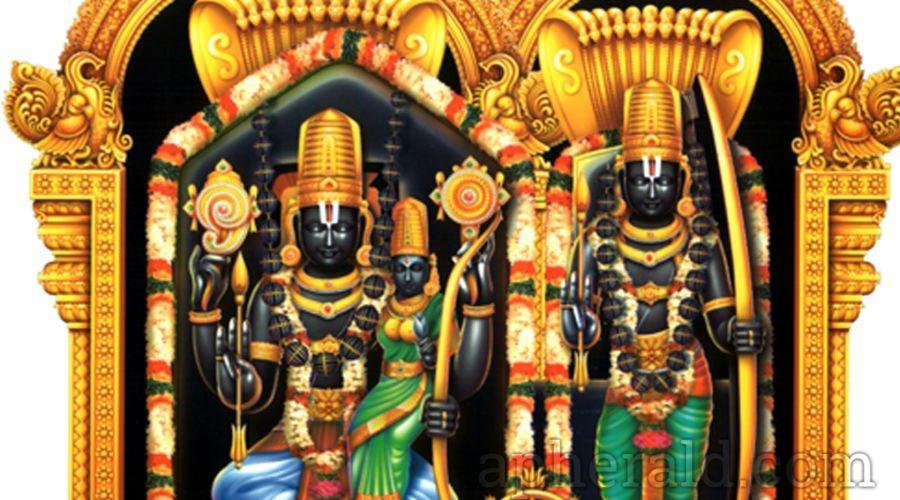
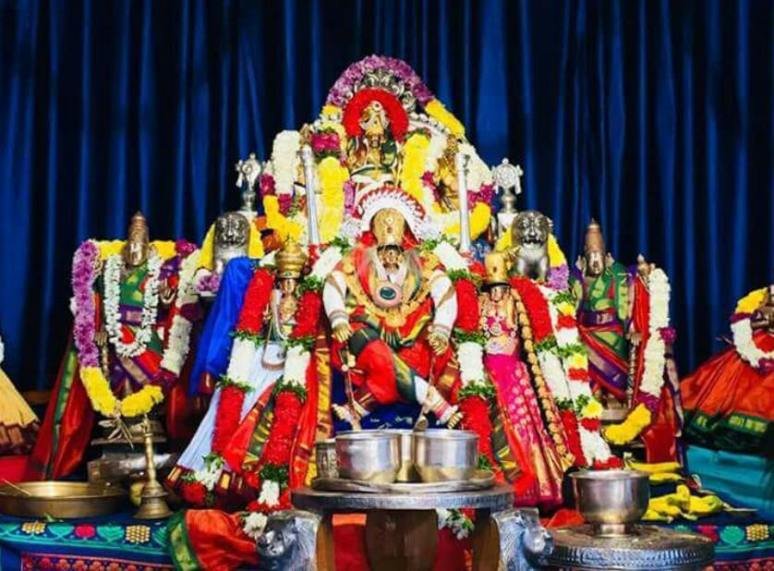
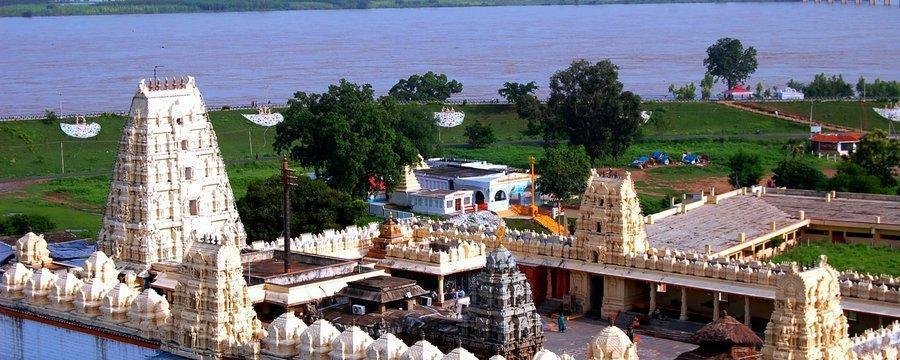
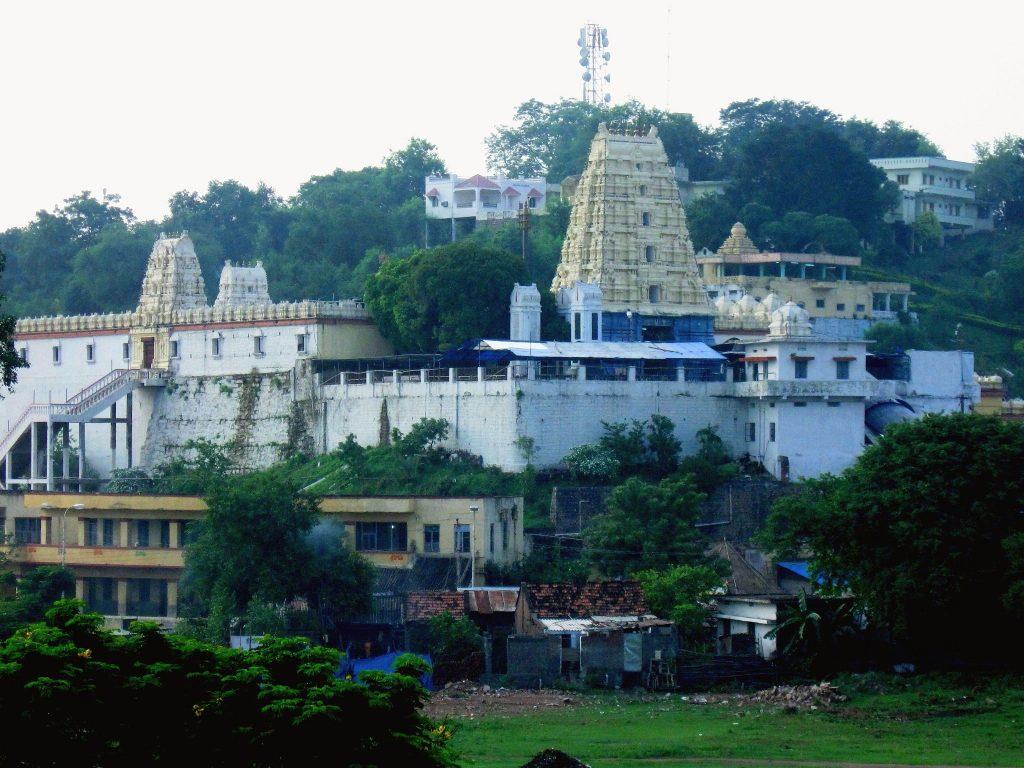
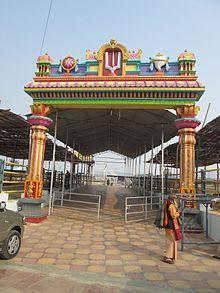
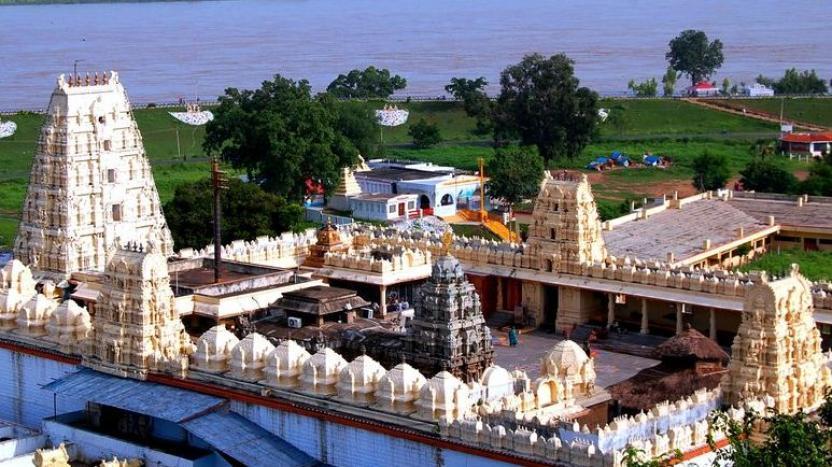

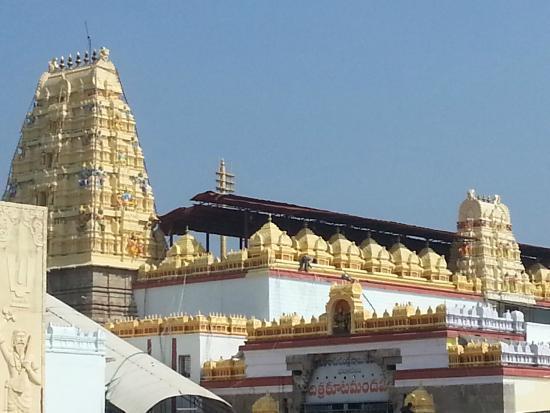
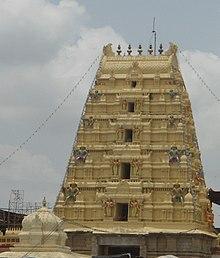
How to Reach:
The Sita Ramachandraswamy Temple is located in the heart of Bhadrachalam, Telangana. The nearest airport to Bhadrachalam is the Rajiv Gandhi International Airport in Hyderabad, which is located approximately 300 km from Bhadrachalam.
From Hyderabad, one can take a taxi or a bus to Bhadrachalam. The journey takes around 7-8 hours by road. There are also several trains that connect Hyderabad to Bhadrachalam.
Once you reach Bhadrachalam, the temple is easily accessible by road. The temple is located in the center of the town and can be reached by walking or taking a rickshaw from the bus stand or railway station.
Contact Details
Official Address

